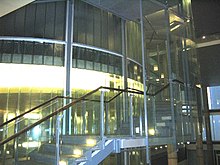Fall-proof glazing
For safety glazing is in construction to glazings of various kinds that prevent lateral person from falling. This includes vertical glazing, glass parapets with continuous handrails and railing infills made of glass. The minimum height difference to be secured is stipulated in the respective state building regulations, but is often more than one meter. Fall-proof glazing in Germany was regulated by the technical rules for the use of fall-proof glazing ( TRAV for short ). These were published by the German Institute for Building Technology (DIBt). The following three categories were distinguished in these rules:
- Linear vertical glazing without parapet or spar (category A)
- Glass balustrade with a handrail mounted in a line at the lower edge (Category B)
- no transfer of horizontal loads at stile height (category C)
If the system did not meet the requirements of the TRAV, it was possible to have this glazing checked and approved via a general building authority approval (AbZ) or an individual approval (ZiE).
In the meantime, the technical rules for the use of fall-proof glazing have been replaced by DIN 18008-4 Glass in Building - Dimensioning and Construction Rules - Part 4: Additional requirements for fall-proof glazing.
Web links
- German Institute for Building Technology
- Contents of the technical rules for the use of fall -proof glazing at Umwelt-online.de
